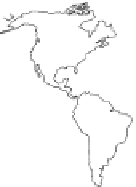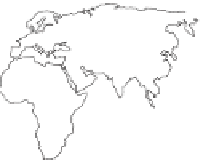Geoscience Reference
In-Depth Information
(a)
(b)
%
-20
-10
-5
5
10
20
Figure 28.3
Relative changes in precipitation (in per cent) for the period 2090-99, relative to 1980-99. Values are multi-model
66 per cent of the models agree in the sign of the change and the stippled areas are where more than 90 per cent of the models
agree in the sign of the change.
Source: I.P.C.C. 2007
evapotranspiration, so the higher levels of precipitation
are not necessarily useful for plant growth.
In addition to expected changes in global aspects of
climate, human-induced changes may develop regionally
and in specific parts of the atmosphere. The rapid increase
in aircraft flights around the world is one of the factors
involved in warming our atmosphere, but they also have
the potential to change cloud amounts, especially of high-
level cloud (
Plate 28.1
).
Under certain conditions, planes
flying near the top of the troposphere can produce a
condensation trail. In many cases this evaporates quickly
to leave a brief visible sign of the plane's track. If the
atmosphere is close to saturation, the condensation
resulting from the addition of moisture and particles
from the engines can survive for a considerable period. In
some cases the whole sky may be covered with a cirrus
type of cloud. Such persistent clouds can have an impact
on both short-wave and long-wave energy exchanges by
decreasing insolation and trapping long-wave energy.
Fortunately these two processes have opposite tendencies
(cooling and warming respectively) so the net effect is
not easy to predict. A study in the United States found
that whilst there had been an increase in frequency of
contrails over the eastern United States, conditions in the
upper troposphere were equally important in affecting
cloud formation; cooler temperatures at the tropopause
produced more contrails.
to life on the planet it is the impact of these changes at
the more local scale which are of greatest significance. For
example, the monsoon systems are responsible for rainfall
and hence water supplies for a large proportion of
humanity, especially in China and India. What is the likely
impact of global warming in these areas? Will greater
evapotranspiration through increased warmth offset the
predicted increase in precipitation? Because of its
economic and social importance, climate modellers have
been trying to establish the probable changes of climate
in these areas, not just changes in absolute amounts, but
also in within- and between-season variability. In other
words, can we expect a simple increase in precipitation
(
Figure 28.3
)
or could there be changes in the length of
the monsoon season, or a change in variability within the
monsoon season? Unfortunately, model predictions are
not consistent. There is a consensus in the IPCC 2007
report that an increase of precipitation would be expected
in the Asian monsoon together with an increase in
interannual variability. The southern part of the West
African monsoon system and the area affected by the
northern Australian monsoon are also predicted to
experience greater precipitation. The northern part of the
West African monsoon (the Sahel) could experience a
decrease in precipitation, together with Mexico and
Central America, in association with increasing amounts
over the eastern equatorial Pacific. Unfortunately there is
no great confidence in these predictions because of
complications brought about by particulate matter in the
atmosphere.
There is evidence in geological records that El
Niño-Southern Oscillation (ENSO) is a long-term feature
of the Pacific and through teleconnections into other
Although an increase in global temperatures and varying
precipitation changes are potentially extremely important



































































































































































































































































































































































































































































































































































































































































































































































































































































































































































































































































































































































































































